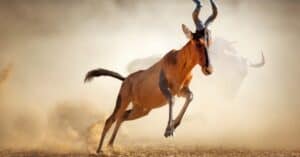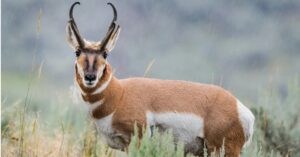Antelopes are usually known for their grace and dexterity, but some are also surprisingly large. Two of the biggest in the world are the kudu and the eland. These African mammals share several characteristics but also deviate in important ways. Compare the kudu vs eland to discover all about these two antelopes.
Two species of kudus exist within the genus Tragelaphus: the lesser kudu (Tragelaphus imberbis) and the greater kudu (Tragelaphus strepsiceros). Likewise, two species of elands exist within the genus Taurotragus: the common eland (Taurotragus oryx) and the giant eland (Taurotragus derbianus). Below you will find the key differences between kudus and elands.
Comparing a Kudu vs Eland
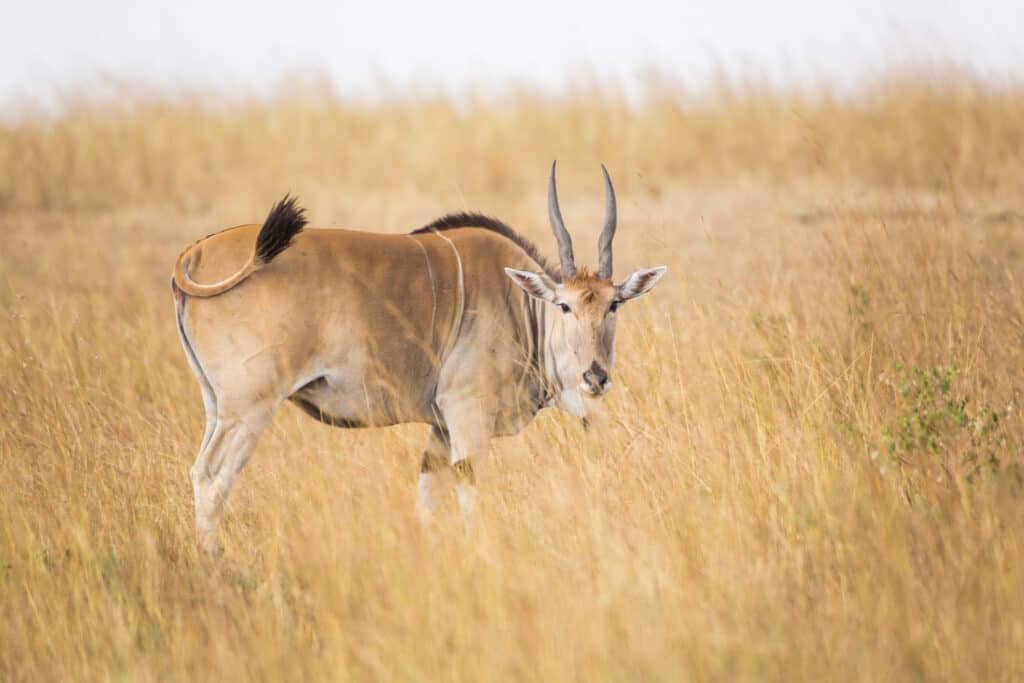
Giant elands reach anywhere from 50-70 inches at the shoulder.
©O’sokin/Shutterstock.com
| Kudu | Eland | |
|---|---|---|
| Scientific Name (Genus) | Tragelaphus | Taurotragus |
| Habitat | Northeastern, eastern, and southern Africa Scrublands, savannas, and woodlands Lowlands, hills, and mountains | Central, western, and southern Africa Savannas, woodlands, deserts Foothills |
| Size | Lesser kudu: 35-41 inches tall, 130-230 pounds Greater kudu: 47-59 inches tall, 260-600 pounds | Common eland: 47-63 inches, 660-2070 pounds Giant eland: 50-70 inches, 660-2200 pounds |
| Appearance | Spiral horns (males), spinal crest, facial stripes or patches, greyish-brown or reddish-brown coat, 6-15 white stripes on body | Tight spiral horns (males and females), tawny coat, up to 12 white stripes on body, large dewlap, black marks on body and head |
| Reproduction | Breeds any time of year (lesser kudu) or near the end of the rainy season (greater kudu), gives birth to 1 calf at a time | Breeds any time of year, gives birth to 1 calf at a time |
| Behavior | Males: Solitary, unaggressive Females: Gregarious, unaggressive | Males: Solitary or gregarious with other males, unaggressive Females: Gregarious, unaggressive |
The Key Differences Between a Kudu and an Eland
The key differences between kudus and elands are habitat, size, appearance, reproduction, and behavior.
Kudu vs Eland: Habitat
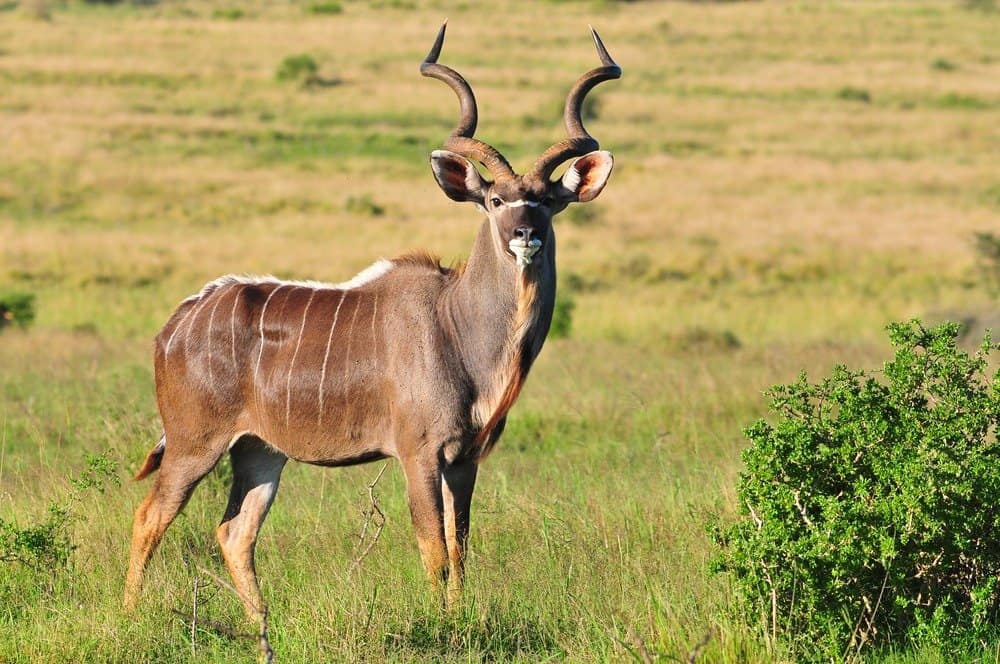
Kudus, like elands, live in Africa among savannas, grasslands, and woodlands.
©Michael Potter11/Shutterstock.com
Africa is home to both species of kudus. The lesser kudu inhabits several countries in northeastern Africa, including Ethiopia, Kenya, Somalia, Uganda, Tanzania, and South Sudan. The greater kudu inhabits several countries in eastern and southern Africa, including Ethiopia, Tanzania, Kenya, Zambia, Angola, Namibia, Botswana, Zimbabwe, and South Africa. Kudus freely roam these countries’ scrublands, savannas, and woodlands, though both species avoid open areas without adequate cover. They are equally able to survive in lowlands, hills, or mountains.
Like kudus, elands live in Africa. The common eland inhabits countries like Ethiopia, South Sudan, Angola, Namibia, and South Africa. Countries hosting the giant eland include the Central African Republic, Guinea, Cameroon, Chad, Mali, Senegal, and South Sudan. Elands occupy various habitats like savannas, woodlands, deserts, and foothills.
Kudu vs Eland: Size
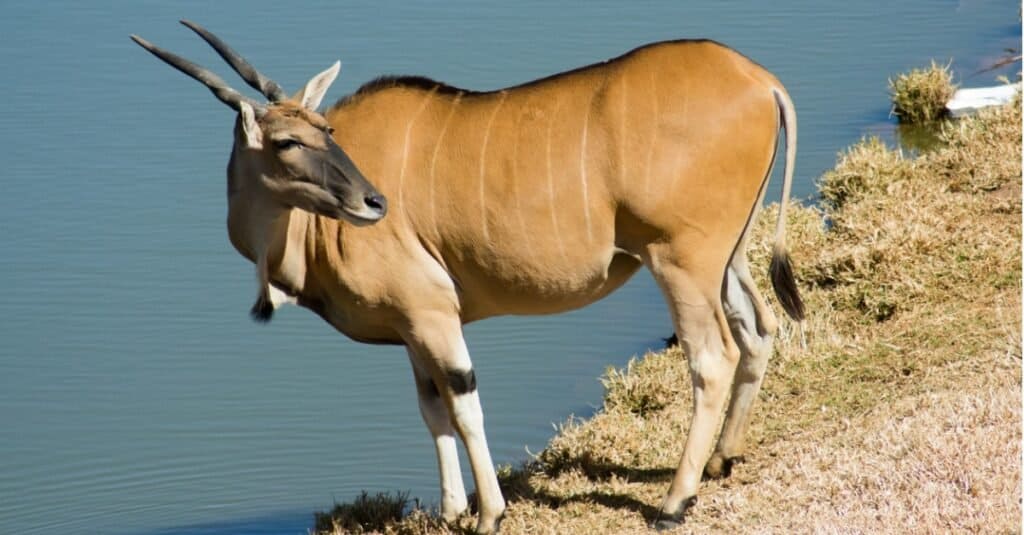
The eland is one of the largest antelopes in the world, weighing as much as 2,200 pounds.
©iStock.com/Mohammad Ikhtiar Sobhan
Kudus are smaller than elands, though they are still large antelopes. Lesser kudu females grow up to 35-39 inches tall at the shoulder and weigh 130-160 pounds. Lesser kudu males reach 37-41 inches tall at the shoulder and weigh 200-230 pounds. Greater kudus are significantly larger, with females standing up to 47 inches at the shoulder and weighing 260-460 pounds. Greater kudu males are the biggest, with a shoulder height of 51-59 inches and a weight of 420-600 pounds.
Elands are among the largest antelopes in the world. Common elands are smaller than their giant cousins, with females standing 47-59 inches at the shoulder and weighing 660-1320 pounds. Males stand up to 63 inches and weigh between 880-2070 pounds. Giant elands reach anywhere from 50-70 inches at the shoulder. Females weigh approximately the same as common female elands, though giant eland males can reach a whopping 2200 pounds.
Kudu vs Eland: Appearance

Both kudus and elands have sizable spiral horns up to 4.5 feet in length.
©kkphotography2/Shutterstock.com
Aside from the size difference, lesser and greater kudus appear similarly. Males of both species have spiral horns, growing much larger in the greater kudu, up to 4.5 feet long. White facial marks may appear in stripes, cheek patches, and chevrons. Males’ coats are generally greyish-brown, while females tend to be reddish-brown. Some individuals’ coats may be bluish-grey. Kudus of both species have white stripes on their bodies: 11-15 for lesser kudus and 6-10 for greater kudus.
Elands may appear similar to kudus with their tawny coats and up to 12 white body stripes. Dark markings may be present on the body or the head and ears. Both males and females have tight spiral horns, though males’ are larger, extending over 4 feet in length. Both species of elands have large dewlaps.
Kudu vs Eland: Reproduction
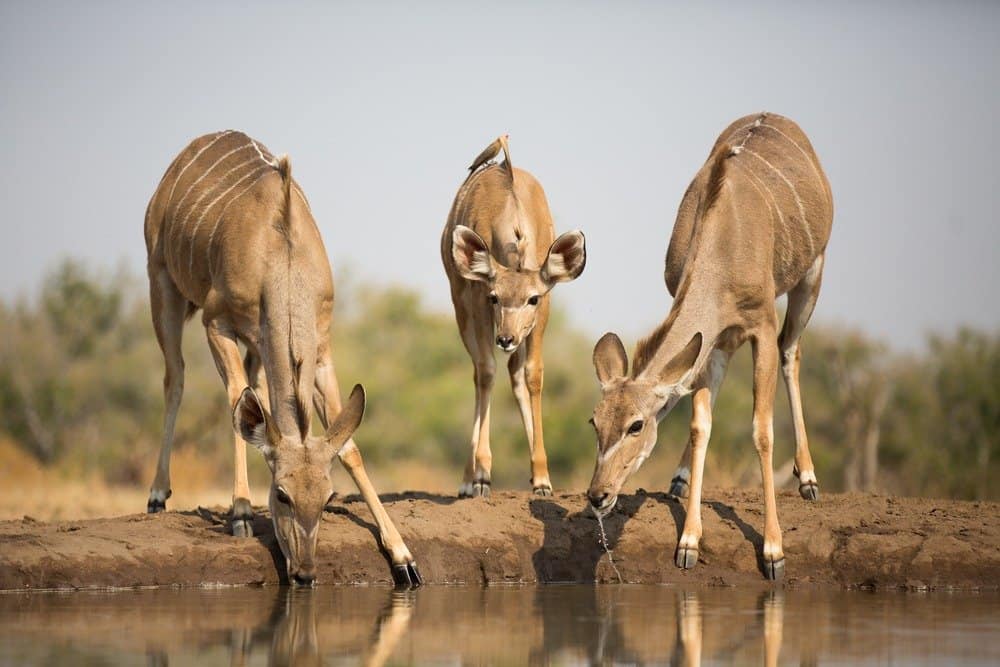
Kudus and elands give birth to 1 calf at a time after a gestation period of up to 9 months.
©Villiers Steyn/Shutterstock.com
Lesser kudus reach sexual maturity by 18 months, breeding and calving at any time of year. Greater kudu females reach sexual maturity by 15-21 months, though males don’t mature until 21-24 months. This species only breeds near the end of the rainy season, from February to June. Females of both species leave their herd to give birth after a 7-9 month gestation period. By 3-4 months, the calf is ready to accompany its mother back to the herd. By the age of 6 months, it should be ready for independence.
Female elands typically reach sexual maturity between 12-36 months while males mature by 4-5 years. Elands have a gestation period of about 9 months and wean their calves after about 6 months. Like kudus, elands only give birth to 1 calf at a time.
Kudu vs Eland: Behavior
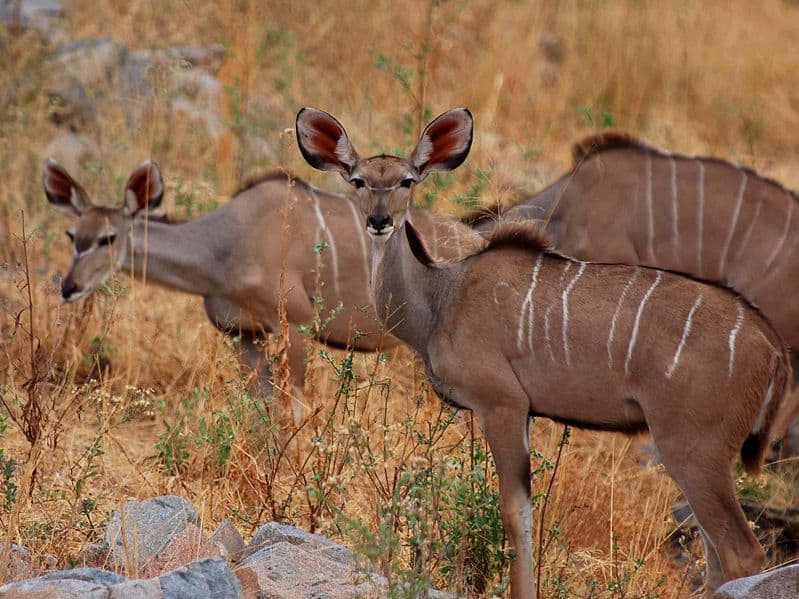
Kudus and elands are nonaggressive animals. Males tend to be solitary, while females are gregarious.
Kudus are generally docile and unaggressive animals except at mating time. Even then, males prefer to settle disputes via a lateral display (standing sideways to display one’s size). If necessary, males lock horns and push one another until one gives in. Bull kudus are typically solitary, while cows are gregarious, living in herds of up to 24 individuals.
Similarly, elands are unaggressive in most instances, even males. Due to their nomadic nature, elands rarely claim or defend territories as their own on a long-term basis. Males either live a solitary existence or join small bachelor groups of adult males. Females live in herds with other females, often separate from a nursery group comprising juvenile elands. These calves may become more bonded to one another than to their mothers. At breeding time, all groups come together. Herds may number up to 500 individuals.
Kudu vs Eland: Diet and Predators
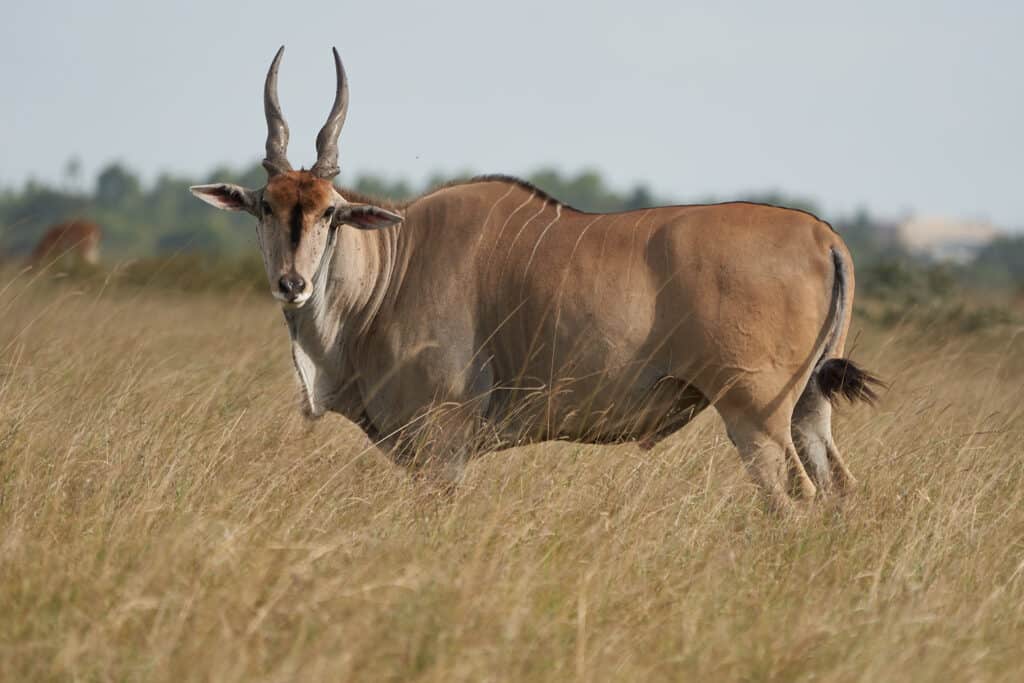
Elands will eat the leaves of flowering plants whenever possible.
©Rocchas/Shutterstock.com
Both kudus and elands are herbivorous, eating leaves, twigs, shrubs, flowers, herbs, grasses, seeds, fruits, and roots. Elands will eat the leaves of flowering plants whenever possible. Due to their size, both antelopes make ready prey for larger predators, including lions, leopards, hyenas, African wild dogs, and humans.
Kudu vs Eland: Lifespan

Lesser kudus live 10-15 years in the wild, with greater kudus living up to 23.5 years.
©yykkaa/Shutterstock.com
Kudus live shorter lives than elands on average, and lesser kudus live 10-15 years in the wild, with greater kudus living up to 23.5 years. By contrast, common elands live between 15-20 years in the wild, though giant elands may live up to 25 years.
The photo featured at the top of this post is ©
Thank you for reading! Have some feedback for us? Contact the AZ Animals editorial team.



